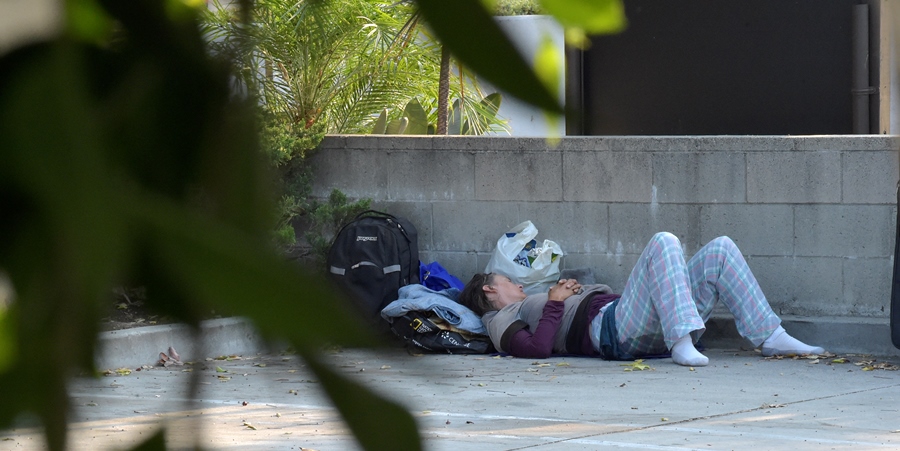 View Winners →
View Winners → Pasadena Homeless Population Grows by 18 Percent


The 2018 Pasadena Homeless Count saw an 18 percent increase in the city’s homeless population. – Photo by Terry Miller / Beacon Media News
SGV homeless population increased by five percent
By Gus Herrera
For the first time in four years, homelessness has decreased in Los Angeles County. Unfortunately, the numbers continue to slowly rise in the San Gabriel Valley (SGV) and Pasadena.
The Los Angeles Homeless Service Authority (LAHSA) recently released their results from this year’s homeless count and the total number of homeless individuals in the county fell from 55,048 in 2017, to 52,765. But, despite the slight decline over this past year, the overall numbers are still substantially higher than they were when we began this decade, with LAHSA’s 2010 count tallying a total of 35,926 homeless individuals in LA County.
Although LAHSA’s count does not specifically cover the City of Pasadena, which carries out its own annual homeless count, they do consider the SGV at large.
This year’s data showed a five percent increase in the SGV homeless population (4,282 total individuals), a modest bump compared to Pasadena’s 2018 count, which saw an 18 percent increase in the city’s homeless population (677 total individuals).
“This is a huge problem for the city and, really, the region,” said Pasadena Mayor Terry Tornek when the city council heard the 2018 Pasadena Homeless Count results on April 30, “[it’s a] very divisive, almost overwhelming problem … it’s the single biggest source of complaints and concerns that I get from constituents.”
Although the overall numbers for the SGV show growth, the story is different for each individual city. While some areas, including Altadena, Arcadia, Duarte, San Gabriel, and Temple City saw a decline in their relatively small homeless populations, others such as El Monte, Monrovia, and South Pasadena witnessed a significant increase, similar to Pasadena.
El Monte’s homeless population grew from 268 last year, to 543; Monrovia went from 39 homeless individuals in 2017, to 70 this year; and South Pasadena’s numbers doubled from 11, to 22.
Additionally, the majority of these growing homeless populations remain unsheltered – 68 percent in Pasadena, 95 percent in Monrovia, and 100 percent in El Monte. This trend also holds true on the county-wide level, with 77 percent of the total homeless population categorized as unsheltered.
The use of cars, makeshift shelters, and campers/RVs has also risen, something that has become increasingly evident to anyone who has traveled on or near a freeway over the past year.

Map showing the density of homeless populations throughout Los Angeles County. – Courtesy photo / Los Angeles Homeless Service Authority
Another alarming figure revealed from this year’s counts is that the homeless populations are growing older – in Pasadena, the number of homeless individuals age 50 and older increased by 65 percent, while the number of homeless persons 62 years and older in the SGV increased by 116 percent.
According to LAHSA’s presentation, “more people are falling into homelessness for the first time,” a number which grew from 8,044 in 2017, to 9,205 in 2018. Approximately 46 percent of these individuals experiencing homelessness for the first time said it was “due to a loss of employment or other financial reasons” – financial reasons which are only exacerbated by the county’s serious lack of affordable housing. According to LAHSA, Los Angeles needs over 560,000 new affordable housing units for low-income renters, 16,000 more than last year.
LAHSA’s data also revealed that, since 2000, the median rent in LA County “has increased 32 percent, while median household income has decreased three percent.”
Similarly, a Pasadena planning commission staff report from their July 25 workshop on the conversion of motels/hotels to affordable housing revealed that “43 percent of owners and 51 percent of renters overpay for housing in the City of Pasadena,” per the current housing element.
“Most notably, lower-income households have higher rates of overpayment for housing,” continues the report, “[and] the high number of lower-income renters who are overpaying for housing in Pasadena indicates a large population at risk of becoming homeless if rents are increased or major life events arise such as job loss or medical expenses.”
As far as potential solutions go, LAHSA and Pasadena staff both seem to agree that more housing is needed. A Pasadena city staff report from the April 30 city council meeting calls for more supportive housing developments and rapid re-housing. Supportive housing developments are “needed to offset recent increases in homelessness, especially among the elderly,” while rapid re-housing could be a formidable tool to help those “non-chronically homeless” individuals “who have been pushed into homelessness as a result of the housing crisis,” says staff’s report.
At that same council meeting, William Huang, Pasadena’s director of housing and career services, revealed that in 2017 the city housed a total of 161 individuals using these two methods (97 via rapid re-housing and 64 through supportive re-housing). But, despite the relative effectiveness, Huang said that, “unless significant measures are taken,” the city’s homeless population “will grow to over 1,000 people in next five years.”
LAHSA also sees supportive and rapid re-housing programs as key tools to combat homelessness and is hopeful that LA County’s $3.5 billion in Measure H funds and $1.2 billion in Proposition HHH funds will be invested to create more housing over the next 10 years.






































































































